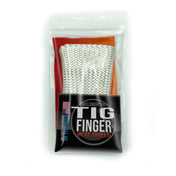7 TIPS FOR TIG WELDING ALUMINUM
- A simple turn of the AC balance knob can make a huge difference. When you set the AC balance to not enough cleaning action, you get black dots in the weld puddle. A simple turn of the knob can usually clean up the puddle.
- A small inboard tack can prevent the end tack from breaking when welding from an end on aluminum. Aluminum is hot short and weak when hot so a tack weld on the end can turn loose if you start on the tack. By adding a small tack a half inch inboard, you can avoid lots of problems.
- Making big steps on thick aluminum is usually not a problem but for thinner aluminum, big steps can create a hole..especially if there is any gap at all…frequent dabs of filler rod at frequent spacing helps prevent problems on thin aluminum.
- High AC frequency might be annoying to hear without ear plugs but can really focus the arc….if your machine has enough amperage to handle higher frequency settings. Sometimes its worth it to put in some ear plugs. The primeweld 325x is capable of tig welding .125" aluminum on 115 volt power for short runs...even with the water cooler running.
- The rule of 33 can be a big help on thin steels but also can help on thin aluminum. The rule of 33 is a pulse setting using 33 pulses per second with 33% background and 33% pulse width. 33 pulses flutters the arc and agitates the puddle but is not difficult to watch. I personally don't use pulse rates above 2pps or below 33 due to it hurting my eyes and giving me a headache.
- Thick open corner joints that need a wide bead can benefit from a low AC frequency setting like 50hz…especially if you are pushing the upper amperage limits on your tig welder.
- 120hz is a great all around AC frequency setting if you just want to set it and forget it. In fact, some machines like the miller diversion have an AC frequency fixed at 120hz because they feel it is a good all around setting.










3 comments
i wish you would bring back the yearly “Welding tips & Tricks” DVDs it was so nice for a “computer Dense” old fart like me to be able to watch (and share) your welding knowledge again and again, without fear of missing anything or loosing the videos. LL&P
Hey Jason,
thanks for your comment, There are some situations that are more forgiving than others, For example, on aluminum, the hot tip cools so quickly that keeping tip in argon is forgiving.
Other metals like stainless are not nearly as forgiving.
Root passes on pipe with carbon steel can be done with dip keyhole technique or laywire and both can work but tip of wire does need to be kept shielded if possible. Its not always a big deal but it is best practice.
Jody
I love your videos and respect your opinions and views on welding. I noticed that when you dab your filler rod and pull out , are you pulling out of the gas range ? I see a lot of so called professionals just lay the filler rod in the root and never dab. Walking the cup vs stalk of dimes ? I’m interested in doing it right. Your thoughts.